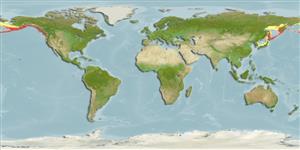>
Perciformes/Zoarcoidei (Eelpouts and pricklebacks) >
Lumpenidae (Eel pricklebacks)
Etymology: Lumpenus: Latin, lumpus, an uncouthlooking spiny-finned fish of a leaden-blue colour (Ref. 45335); sagitta: Name from sagitta meaning arrow, referring to the long slender body (Ref. 6885).
Environment: milieu / climate zone / depth range / distribution range
Ökologie
seewasser benthopelagisch; tiefenbereich 0 - 425 m (Ref. 50550). Temperate; 64°N - 33°N, 127°E - 122°W
North Pacific: Sea of Japan and Sakhalin, Russia to St. Lawrence Island in the Bering Sea to Adak Island in the Aleutian chain and San Francisco, California, USA.
Size / Gewicht / Alter
Maturity: Lm ? range ? - ? cm
Max length : 51.0 cm TL Männchen/unbestimmt; (Ref. 2850); max. veröff. Alter: 8 Jahre (Ref. 56557)
Kurzbeschreibung
Morphologie | Morphometrie
Rückenflossenstacheln (insgesamt): 66 - 72; Rückenflossenweichstrahlen (insgesamt): 0; Afterflossenstacheln 1; Afterflossenweichstrahlen: 45 - 50. Caudal fin narrow with oval free end; anal fin occasionally absent; pectorals large, bluntly pointed (Ref. 6885). Pale green on dorsal surface, cream ventrally; brown or green bars along midside and streaks or spots on upper part of sides; brown bars and dots on dorsal fin form bands parallel to fin margin and, on caudal fin, produce vertical bars; other fins pale; lining of mouth pale (Ref. 6885).
Found in shallow bays and offshore waters (Ref. 2850); on sand mixed with silt, pebbles, and stones to depths of 425; usually shallower than 200 meters (Ref. 51666). Sometimes takes hooks using marine worms as bait (Ref. 6885).
Life cycle and mating behavior
Geschlechtsreife | Fortpflanzung | Ablaichen | Eier | Fecundity | Larven
Eschmeyer, W.N., E.S. Herald and H. Hammann, 1983. A field guide to Pacific coast fishes of North America. Boston (MA, USA): Houghton Mifflin Company. xii+336 p. (Ref. 2850)
IUCN Rote Liste Status (Ref. 130435)
Bedrohung für Menschen
Harmless
Nutzung durch Menschen
Mehr Information
NamenSynonymeMetabolismusRäuberÖkotoxikologieFortpflanzungGeschlechtsreifeAblaichenSpawning aggregationFecundityEierEientwicklung
Alter/GrößeWachstumLänge-GewichtLänge-LängeLängenhäufigkeitenMorphometrieMorphologieLarvenLarven Pop.Dyn.RekrutierungDichteBRUVS
ReferenzenAquakulturAquakultur ProfilZuchtlinienGenetikElectrophoresesVererbbarkeitKrankheitenVerarbeitungNutrientsMass conversion
PartnerBilderStamps, Coins Misc.LauteCiguateraGeschwindigkeitSchwimmstilKiemenoberflächeOtolithsGehirngrößeSehfähigkeit
Tools
Zusatzinformationen
Download XML
Internet Quellen
Estimates based on models
Preferred temperature (Ref.
123201): 0.9 - 8.1, mean 4.8 °C (based on 375 cells).
Phylogenetic diversity index (Ref.
82804): PD
50 = 0.6250 [Uniqueness, from 0.5 = low to 2.0 = high].
Bayesian length-weight: a=0.00129 (0.00052 - 0.00322), b=2.98 (2.76 - 3.20), in cm total length, based on LWR estimates for this (Sub)family-body shape (Ref.
93245).
Trophic level (Ref.
69278): 3.3 ±0.2 se; based on diet studies.
Widerstandsfähigkeit (Ref.
120179): mittel, Verdopplung der Population dauert 1,4 - 4,4 Jahre. (Preliminary K or Fecundity.).
Fishing Vulnerability (Ref.
59153): Moderate vulnerability (40 of 100).
